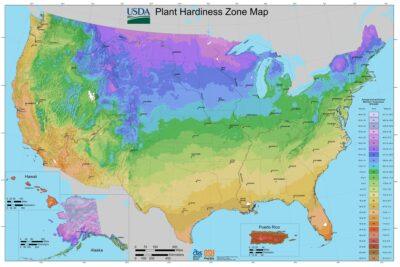The Essential First Step To A Blue-Ribbon Garden This Year is courtesy of Total Survival
You need to look at your area and your own yard and consider the weather and conditions in your region before planting.
Have you ever had the disappointment of planting your favorite vegetable but found it just didn’t grow?
This may be why: It may have failed because the vegetable was not suited to your Hardiness Zone or because you were simply not paying enough attention to your local frost dates. Experienced gardeners use these guides yearly. They are simple guides that help you to select the type of plants that will grow well in your area and when to plant them. This gives you a better chance at a successful garden.
Let’s take a look at the different aspects of Hardiness Zones and Frost Dates. This way we can get a better understanding of what they mean and how they can help us.
Hardiness Zones
Make sure that you use the Hardiness Zone map as a starting point. You need to look at your area and your own yard and consider the weather and conditions in your region before planting.
Zones tell us which plants can survive in our region’s climate during a regular gardening season. They can also advise us on which shrubs and trees can survive outdoors year-round in our area. Usually, on the back of seed packets, you will find a map showing where the plant will do best. You can find the same or similar map on plant tags.
Canada and the United States both have their own divisions of Hardiness Zones. Canada has nine. They range from 0 to 8, with 0 being the harshest. Within each zone, there is another division, A and B, with A being harsher. Wind patterns, rainfall, snow cover, average number of frost-free days and temperatures (minimum and maximum) are used to create the zone map.
The USDA Hardiness Zone Map is only one of several maps to help gardeners. However, this is the map most gardeners turn to for advice and guidance. This map divides North America into 11 zones, and each zone varies within 10 degrees either warmer or colder than the other zones.
Frost Dates

Zones tell us which plants can survive in our region’s climate during a regular gardening season.
These dates usually reference the first and last day’s frost of a year. For example, the first day would occur in autumn and the last day would happen in early spring of the following year.
By using these dates as a guideline, you will be able to plan when you can start planting an outside garden or preparing your indoor one. It is helpful because you wouldn’t want to plant a vegetable like tomatoes in August if the frost date is in September. You wouldn’t have time to grow and harvest them.
The amount of time between the two frost dates determines how long your growing season will be. You can then plan what vegetables will grow during the time you have. You will need to plant something that will mature during the time you have, or you can use cold frames. Plants will also stop producing if you have several days in a row of continuous temperatures.
Heat Zones
Because only low temperatures are addressed on the Hardiness and Frost Zone maps, a Heat Zone Map was created to look at the other end of the scale.
New Natural Fertilizer Doubles Garden Production!
The map was developed to show the number of days with temperatures of over 86 degrees Fahrenheit. Unlike Hardiness Zones, Heat Zones do not appear on seed packages. Be aware that Hardiness Zone numbers and Heat Zone numbers are not always the same, so check out the zone maps to confirm where you are.
Points To Remember
The maps don’t take into account:
- Day Length. If you live in an area with shorter days, some plants (like onions) won’t thrive because they use day length to signal growth. Short days equal less growth.
- In a single region, there are differences in the amount of rain each section of that region receives. The maps assume all plants are getting enough water.
- Low Days. It is possible to have two days of the average lowest temperature, or you could have 20 depending on your area. You need to know if you should plant a fall garden or a winter garden.
- Micro-climates. If you live in an urban area, it may be hotter than a rural area nearby because of the amount of pavement. Mountains also create micro-climates because they can act as windbreaks.
One of the best things you can do for your garden is to be observant in your environment. Know your garden and the weather in your area. Not only are good gardeners aware of the Hardiness Zones and Frost Dates, but they realize weather changes from year to year and the garden can also be affected by being on either the south or north side of the yard.
So look up your region and prepare for a successful growing season. Planning ahead is always a good idea so you can enjoy your garden, no matter what the temperature may be.
Do you have tips in using Hardiness Zone maps or frost dates? Share your advice in the section below:
Get $367.52 Worth Of Survival Blueprints … Absolutely Free!
The post The Essential First Step To A Blue-Ribbon Garden This Year appeared first on Off The Grid News.
This Article Was Originally Posted On offthegridnews.com Read the Original Article hereOriginally Published Here: The Essential First Step To A Blue-Ribbon Garden This Year

No comments:
Post a Comment